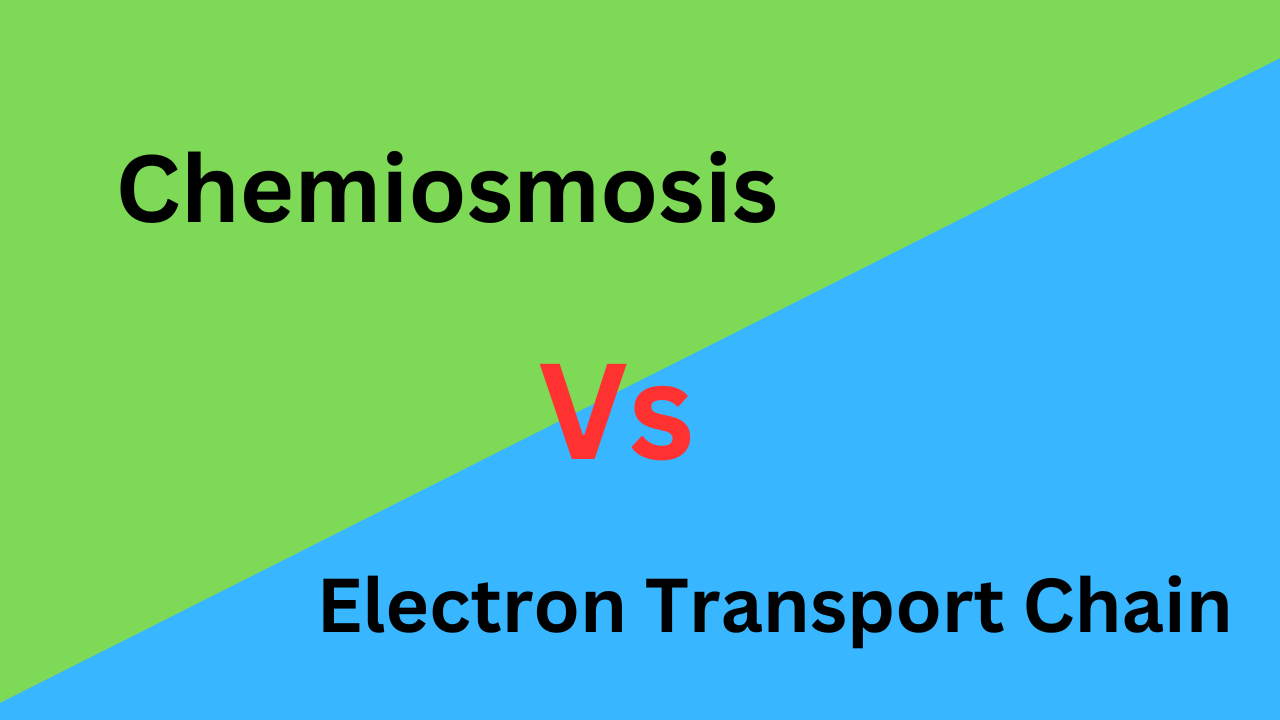What is the main difference between chemiosmosis and electron transport chain? The former uses energy in form of a proton gradient to synthesize ATP, while the latter passes electrons from one molecule to another for releasing energy.
All living organisms need oxygen for survival. Oxygen is crucial in the body cells to facilitate oxidative phosphorylation in the final stage of cellular respiration. Chemiosmosis and electron transport chain are the main components during oxidative phosphorylation.
It can be challenging to determine the relationship between electron transport chain and chemiosmosis. We wrote this article to help you understand their differences and similarities during your revision for exams.

Difference Between Chemiosmosis and Electron Transport Chain With Table
| Basic Terms | Chemiosmosis | Electron Transport Chain |
| Meaning | Refers to the movement of hydrogen ions across membrane via ATP synthase while producing ATP energy. | Refers to the cluster of proteins that transport electrons via membrane in mitochondria to form proton gradient that drives the creation of ATP. |
| Process | Uses proton gradient established by electron transport chain to produce ATP. | Uses energy stored in the NADH to produce a proton gradient. |
| Integral Membrane Proteins | Uses ATP synthase | Uses NADH coenzyme Q reductase, coenzyme Q, succinate dehydrogenase, cytochrome bc1 complex, cytochrome c, and cytochrome c oxidase. |
| Functions | Promote cellular respiration during oxidative phosphorylation. | Regenerates electron carriers.
Makes a proton gradient. |
What Is Chemiosmosis?
Chemiosmosis is a crucial process that powers cellular energy production, like in our bodies’ cells. Think of it as a mini-power plant within cells. During this process, a flow of protons (tiny charged particles) across a membrane generates energy.
This membrane acts like a dam, and as protons flow back across it, they pass through an enzyme called ATP synthase. This enzyme acts like a turbine, using the proton flow to create a molecule called ATP, which stores energy.
ATP is like a rechargeable battery, providing the energy cells need to perform various tasks, from muscle contractions to sending nerve signals.
What Is Electron Transport Chain?
The Electron Transport Chain (ETC) is a critical process in cell energy production, like a relay race for electrons. Happening within tiny structures called mitochondria, the ETC passes electrons along a series of protein complexes embedded in the inner mitochondrial membrane.
As electrons move through these complexes, they release energy, which is used to pump protons across the membrane. This creates a gradient, like water behind a dam.
The energy from protons flowing back through an enzyme called ATP synthase is then used to make ATP, the cell’s energy currency. The ETC converts electron energy into ATP, fueling various cellular activities.
Subscribe To My Channel
Main Difference Between Chemiosmosis and Electron Transport Chain
- Electron Transport Chain (ETC) moves electrons through protein complexes to create an electrochemical gradient while Chemiosmosis uses the electrochemical gradient to generate ATP.
- ETC involves electron transfer through protein complexes releases energy while Chemiosmosis involves Protons flow back through ATP synthase, producing ATP.
- ETC occurs along the inner mitochondrial membrane while Chemiosmosis takes place at the same inner mitochondrial membrane.
- ETC converts electron energy into an electrochemical gradient while Chemiosmosis converts the electrochemical gradient into ATP.
- ETC emphasizes the movement of electrons while Chemiosmosis focuses on the proton flow and ATP production.
- ETC generates a proton gradient while chemiosmosis utilizes the proton gradient to synthesize ATP.
- ETC provides the necessary components for chemiosmosis while Chemiosmosis produces ATP, the cellular energy currency.
Similarities Between Chemiosmosis and Electron Transport Chain
- Both processes occur within the mitochondria.
- Both processes play crucial roles in the production of ATP
- Both processes involve the movement of protons (H+ ions) across the inner mitochondrial membrane.
- Both processes are closely interconnected with the Electron Transport Chain (ETC) providing the necessary electron flow that drives the creation of an electrochemical gradient for chemiosmosis.
- Both processes rely on protein complexes embedded in the inner mitochondrial membrane to facilitate the movement of protons and electrons.
- Both processes are central to the field of bioenergetics
- Both processes are integral parts of cellular respiration, the metabolic pathway that generates ATP through the oxidation of nutrients.
- Both processes involve the conversion of energy from electron transfers into a usable form of energy in the cell (ATP).
- Both processes culminate with the action of ATP synthase, an enzyme that utilizes the proton gradient to synthesize ATP.
Final Thoughts from Experts
Chemiosmosis and the Electron Transport Chain (ETC) are pivotal components of cellular energy production though they serve distinct yet interconnected roles.
The ETC acts as the initial stage, orchestrating the movement of electrons through protein complexes along the inner mitochondrial membrane, harnessing the energy released during this process to establish an electrochemical proton gradient.
This gradient, akin to water behind a dam, sets the stage for Chemiosmosis, the subsequent step. In Chemiosmosis, the proton flow back through ATP synthase drives the synthesis of adenosine triphosphate (ATP), the cellular currency of energy.
The ETC prepares the groundwork by creating the necessary conditions, primarily the electrochemical gradient, for Chemiosmosis to occur. Chemiosmosis then capitalizes on this gradient to convert stored potential energy into the readily usable ATP molecules.
People Who Read This Also Read:
- Difference between Osmosis and Diffusion.
- Difference between T Cells and B Cells.
- Difference between Red Blood Cells and White Blood Cells.
- Difference Between Inotropic, Chronotropic, and Domotropic.